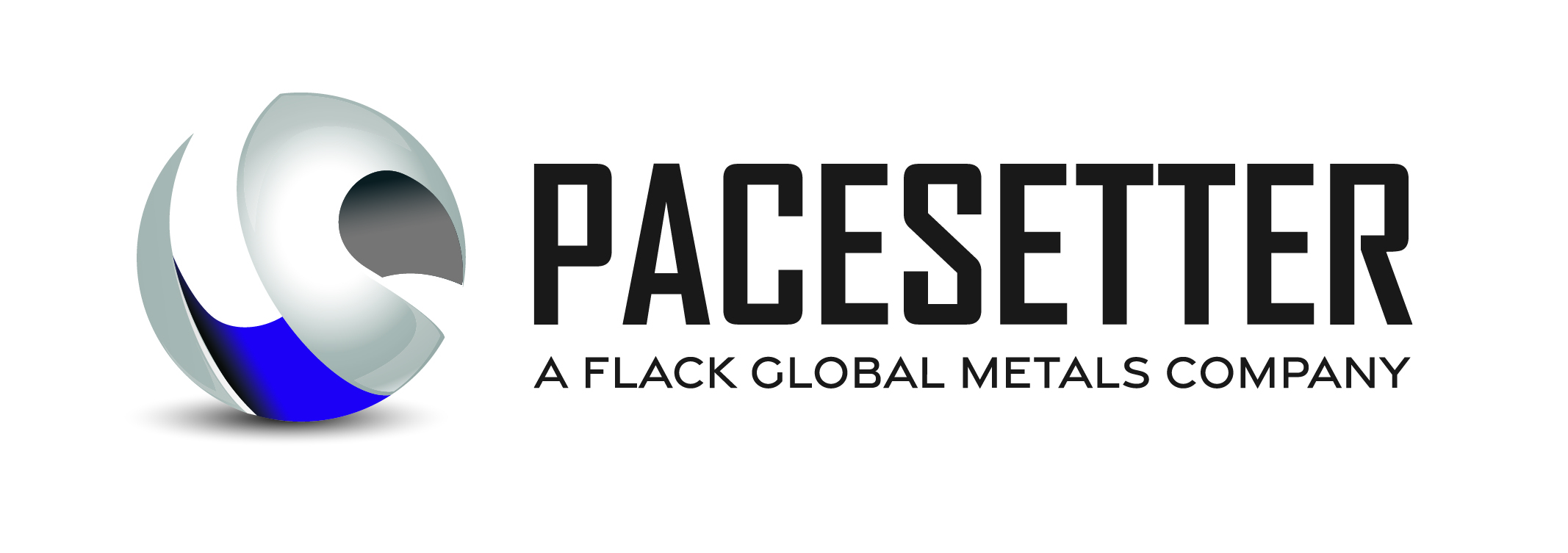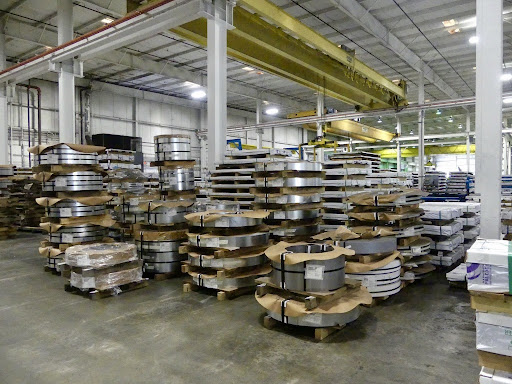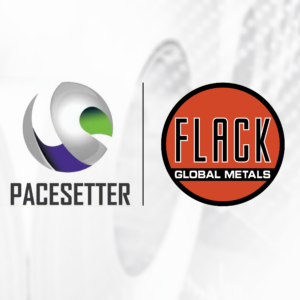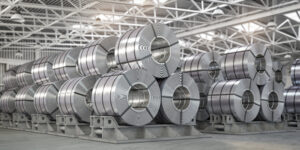What is Steel?
The origins of steel began over 4,000 years ago somewhere in present-day Turkey. However, the steel we use now didn’t evolve until the mid-1700s. Even the popular stainless steel wasn’t invented until 1914!
Now, of course, steel is readily abundant. The U.S. itself contributes 88,000,000 metric tons of raw steel a year.
Today, we classify steel as iron + carbon, often fused with another element(s).
Some common elements used with steel are magnesium, titanium, nickel, chromium, tungsten, and cobalt.
For all your steel product needs, visit our Product page. Or need steel services? We’ve got you covered!
Now, let’s talk about the unique types of this durable, long-lasting, and sustainable material.
What are the Different Types of Steel?
There are many different types of steel. As one of the most trusted steel service centers in the country, let’s review all the different types of steel and how they are used.
What Is Galvanized Steel?
Galvanized steel is coated with 99.5% zinc to create a durable material that resists both corrosion and oxidation.
One method is hot-dip galvanizing (HDG), where steel coils are continuously run through a bath of molten zinc.
The other method is electrogalvanizing (EG) which electrically applies the zinc (vs. dipping). It involves electroplating, anodes, cathodes, and electrolytes. Because this process creates such a smooth finish, it’s most common in the automotive industry.
What’s Galvanized Steel Used For?
- Cars
- Buildings
- Appliances
- HVAC systems
What Is Galvanized Bonderized Steel?
Galvanized bonderized steel is the premier material for the rainwater goods industry. Think gutters, roof flashings, and more.
Like galvanized steel, bonderized steel is dipped in molten zinc. The difference is an additional phosphate bath and a chromate conversion coating to seal it. It’s important to remember that bonderized steel must be painted to avoid rusting.
What’s Galvanized Bonderized Steel Used For?
- Rain gutters
- Downspouts
- Roof flashing
What Is Galvannealed Steel?
Galvannealed steel (GA) is technically a subtype of galvanized steel in that they both contain zinc. However, galvannealed steel has a 90% zinc coating, while galvanized steel has 99.5% zinc.
Galvannealed steel is made by heating coils above air knives to bond zinc and steel. Iron is picked up during this bonding process, accounting for the 90% zinc: 10% iron ratio.
What’s Galvannealed Steel Used For?
- Construction products
- HVAC systems
- Roofing
- Automotive
- Agriculture
- Power transmission
- Hardware
- Piping
What Is Aluminized Steel?
Aluminized steel is composed of iron+carbon+aluminum (and silicon sometimes). This material is tough and highly corrosion resistant. The process involves continuous coil coating, similar to galvanization.
There are two types of aluminized steel:
Type 1: steel coated with 91% aluminum and 9% silicon.
Type 2: steel coated with 100% pure aluminum.
Aluminized steel is heat resistant too. It’s able to withstand temperatures up to 900 degrees Fahrenheit.
What’s Aluminized Steel Used For?
Aluminized steel can be found almost everywhere. Its rust and heat resistance make it a perfect choice for most applications.
- Heat exchangers in residential furnaces
- Commercial rooftop HVAC units
- Automotive mufflers
- Ovens and kitchen ranges
- Water heaters
- Fireplaces
- Barbecue burners
- Baking pans, including cooking sheets, muffin pans, and roasting pans
Learn more about aluminized steel with our ultimate guide.
What Is Cold-Rolled Steel?
Cold-rolled steel is made from large steel billets heated until they reach more than 1700 degrees Fahrenheit. The steel is then flattened using industrial rollers and wound into large coils. The rolling process continues as the material cools, making it up to 20% stronger than other steel.
Cold-rolled steel has more strength and durability than hot-rolled steel, but it’s less malleable with lower thermal conductivity.
What’s Cold-Rolled Steel Used For?
Cold-rolled steel has a variety of applications:
- Kitchen appliances
- Ovens
- Stoves
- Refrigerators
- Furniture
- Filing cabinets
- Garages
- Industrial buildings
What Is Stainless Steel?
Stainless steel is iron + carbon + chromium + a combination of different elements. While other base metals may vary, chromium must be included to create stainless steel.
This type of steel is categorized as low carbon, with chromium accounting for 10.5% or more of the total weight. It’s corrosion-resistant, weather-resistant, and extremely hygienic.
There are three types of stainless steel.
- Austenitic stainless steel: popular, highly corrosion resistant, and non-magnetic
- Ferritic stainless steel: inexpensive and magnetic
- Martensitic stainless steel: least popular, high tensile strength, impact resistant
What’s Stainless Steel Used For?
Because stainless steel is tough, easy to clean, and strong, many industries use it. These include the medical, restaurant, and consumer sectors.
- Surgical tools
- Cutlery
- Sinks
- Refrigerators
- Cookware
- Jewelry
- Firearms
- Automotive and locomotive
- Nuclear storage
Stainless is the smart choice if your project needs a strong, hygienic, and long-lasting material. Learn more about the benefits of stainless with our ultimate guide.
What Is Forged Steel?
Forged steel is the process of alloying iron and steel under extremely high pressure and usually high temperatures (over 800 degrees). There are several methods of producing forged steel. They all result in a material that’s durable yet malleable. Forged steel is perfect for everything from construction to design.
Forged steel is created through several methods: hot forging, hardened forging, and cold forging.
What Is Carbon Steel?
Carbon steel is the purest form of steel, in the sense that it’s just iron + carbon. Welders do not use any other elements to create carbon steel, and it must not contain more than 2% carbon. This is different from other alloy steels that contain other elements and higher levels of carbon (like cast iron).
Carbon steel is divided into three subcategories based on the amount of carbon. They are low, medium, and high-carbon steel.
Low carbon steel: as the name states, this type of steel has the smallest amount of carbon — no more than 0.30%. Low carbon steel is a popular choice for manufacturers because it’s inexpensive and easy to manipulate.
Medium carbon steel: this type of steel contains between 0.31% and 0.60% carbon. While stronger than low-carbon steel, it’s also more difficult to cut or shape. This trend continues as more carbon is added to the steel.
High-carbon steel: As mentioned above, high-carbon steel is the strongest material. But it’s also the most challenging to work with. With between 0.61% and no more than 2% carbon, it’s the most difficult to weld, cut or shape.
What’s Carbon Steel Used For?
Carbon steel has plenty of uses in construction and manufacturing due to its durability. Carbon steel is commonly used for:
- Rail tracks
- Piping
- Fencing
- Axles
- Gears
- Stamps
- Die cuts
- Knives
- Wires
- Even swords!
Carbon steel is an excellent choice for industrial projects due to its unmatched durability. Just remember to account for the difficulty in melding, cutting, and shaping this material.
What Is Alloy Steel?
Alloy steel is iron + carbon + elements(s). These include magnesium, titanium, nickel, chromium, tungsten, and cobalt. Different elements produce different levels of strength, toughness, and hardiness.
Like carbon steel, alloy steel has subcategories. They’re low alloy steel and high alloy steel. The main difference is the amount of alloying elements in the steel.
- Low alloy steel: less than 0.2% alloying elements. Better for low temperature uses under 1,076 degrees Fahrenheit. Weldable and oxidation-resistant.
- High alloy steel: more than 5% alloying elements. Safe in high-temperature environments (over 1,076 degrees Fahrenheit). Corrosion-resistant.
High alloy steel tends to cost more than low alloy steel so check with a Pacesetter expert before purchasing.
What’s Alloy Steel Used For?
Alloy steel is used in a number of industrial applications. Its versatility makes this type of steel a great choice for your projects.
- Pipes
- Microwaves
- Axels
- Toasters
- Shafting
- Ship hulls
- Medals
- Train cars
- Quarters, nickels, dimes, and pennies
What Is Tool Steel?
As the name implies, tool steel is used primarily for construction and manufacturing tools. This incredibly durable type of steel can withstand almost anything. It’s made from iron + carbon + heavy elements like cobalt, nickel, chromium, and tungsten.
With hardiness and heat resistance, tool steel is perfect for high-temperature and high-pressure work environments.
There are several ways to produce tool steel. And each method creates a different kind of tool.
- Hot-working: Steel rises to a temperature above recrystallization as it’s formed.
- Shock-resisting: steel is alloyed with silicon, molybdenum, and carbon to increase hardness.
- Air-hardening: steel is alloyed with chromium.
- Water-hardening: steel is heated then quickly quenched in water.
- Oil-hardening: steel is heated then quickly quenched in oil
- High-speed: steel alloyed with tungsten or molybdenum.
What’s Tool Steel Used For?
Tool steel is used in all sorts of manufacturing machinery like:
- Riveting tools
- Hammers
- Woodworking tools
- Utensils
- Milling tools
- Forging and casting
What Is Damascus Steel?
Originally created in the ancient city of Damascus (present-day Syria), real Damascus steel is no longer produced. However, the process behind that real Damascus steel is alive and well.
Damascus steel is produced by alloying several elements together. The metal is then folded numerous times to create a strong and reliable material. If used to make knives, Damascus steel has incredibly sharp edges that stay sharp for longer.
There are two types of Damascus: carbon Damascus and stainless Damascus. The difference between these lies in the kind of alloy and the amount of alloy used in production.
What’s Damascus Steel Used For?
Damascus steel is not for those hard, dirty jobs. While it’s tough and reliable, this type of steel is perfect for more recreational type uses such as:
- Knives
- Swords
- Firearms
What Is Blue Steel?
Unlike other types of steel, blue steel is not created by mixing elements under high temperatures. Instead, the process of “blueing” is coating high carbon steel with black oxide to prevent rust. The result is a bluish patina on the finished product.
What’s Blue Steel Used For?
While blue steel is more cosmetic than practical, it’s used for many applications, including:
- Guns
- Cast-iron cookware
- Fencing blades
- Bakeware like pans and sheets
What Is Corten Weathering Steel?
Corten, also known as weathering steel, combines its two main characteristics: corrosion resistance and tensile strength.
This type of steel has an oxidized finish, meaning it’s purposely rusty-looking. It may seem counterintuitive, but this process actually enhances the material’s weather resistance.
With the protective oxide film, corrosion is controlled without impacting strength. Corten steel is lightweight, low maintenance, and has an interesting cosmetic look.
On the practical side, it’s malleable — easy to fold, cut, and shape into any form.
What’s Corten Steel Used For?
- Sculptures
- Bridges
- Walls
- Shipping containers
- Garden art
Pacesetter For All Your Steel Needs
Whether you need to purchase steel products or need steel services, Pacesetter’s expert team has you covered. We’ll discuss your project needs and provide you with the best quote for our steel products. We offer a variety of steel processing services, including slitting, blanking, cut-to-length, and toll processing services.
In addition to prepainting finishing services, we can also emboss or perforate your steel to your exact specifications. Contact our team today!




